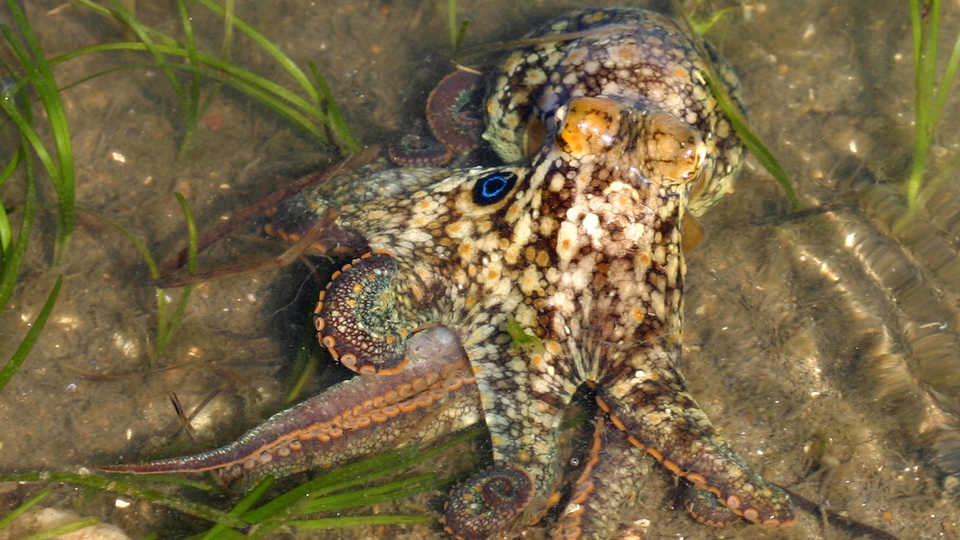Science News
Octo-Genome

Yesterday we wrote about a particularly oddball octopus, but in general octopuses and their cephalopod kin are unusual creatures. “The octopus appears to be utterly different from all other animals, even other mollusks, with its eight prehensile arms, its large brain and its clever problem-solving capabilities,” says the University of Chicago’s Clifton Ragsdale. “The late British zoologist Martin Wells said the octopus is an alien.”
So then it shouldn’t have been a surprise that when Ragsdale and his colleagues completed the first-ever whole genome analysis of the cephalopod, the genome was somewhat alien, too. “With a few notable exceptions, the octopus basically has a normal invertebrate genome that’s just been completely rearranged, like it’s been put into a blender and mixed,” says Caroline Albertin, also of the University of Chicago and co-lead author of the study published yesterday in Nature. “This leads to genes being placed in new genomic environments with different regulatory elements, and was a completely unexpected finding.”
Cephalopods include octopuses, squids, cuttlefish and nautiluses, with an evolutionary history spanning more than 500 million years (long before plants moved onto land). Inhabiting every ocean at almost every depth, they possess unique adaptations such as chemosensory suckers, the ability to regenerate complex limbs, vertebrate-like eyes, and a sophisticated camouflage system. With large, highly-developed brains, cephalopods are the most intelligent invertebrates and have demonstrated elaborate problem-solving and learning behaviors. “The sequencing was an opportunity to look at the genome and see what we can learn about the unique brain and morphology of the octopus,” says Ragsdale.
The team sequenced the genome of the California two-spot octopus, Octopus bimaculoides, and estimates the total length of DNA at 2.7 billion base-pairs, with numerous long stretches of repeated sequences. They identified more than 33,000 protein-coding genes, placing the octopus genome at slightly smaller in size, but with more genes, than a human genome.
The researchers say that the evolution of the octopus genome was likely driven by the expansion of a few specific gene families, widespread genome shuffling, and the appearance of novel genes. The expansion includes protocadherins, a family of genes that regulate neuronal development and short-range interactions between neurons. The octopus genome contains 168 protocadherin genes—ten times more than other invertebrates and more than twice as many as mammals. Another gene family that was dramatically expanded in the octopus includes zinc finger transcription factors, which are mainly expressed in embryonic and nervous tissues and are thought to play roles in development. These expansions could be related to the octopus’s highly-developed brains.
The octopus’s genomic rearrangements were a significant find, too. In most species, specific cohorts of genes tend to be close together on the chromosome. However, most octopus genes show no such connections. Hox genes, for example, control body plan development and cluster together in almost all animals. Octopus Hox genes are scattered throughout the genome with no apparent linkages.
The octopus genome is enriched in transposons, also known as “jumping genes,” which can rearrange themselves on the genome. While their role in octopuses is unclear, the team found elevated transposon expression in neural tissues.
Octopus-specific genes were also identified, large numbers of which were found in the nervous system, retina, and suckers. The researchers were also able to track down the genes involved in adaptive coloration, which allow the octopus to change its skin color and texture in order to blend into its environment and escape predation. “We’ve found hundreds of novel genes that don’t have counterparts in other animals and may be involved in this unique camouflage process,” explains co-author Daniel Rokhsar of UC Berkeley.
The genome could also help uncover the genetic basis for other octopus innovations, such as their elaborate arms with suckers used to sense chemicals in the water as well as feel and grasp; a propulsion system that allows them to jet around underwater; camera-like eyes that are more like humans than other invertebrates; and the presence of three hearts to keep blood pumping across their gills. In addition, Ragsdale says that understanding how the octopus’s distributed brain interacts with its eight arms could help engineers design flexible, prehensile arms for robots. In some environments, especially underwater ones, these could work better than jointed arms and legs.
Image: Jay Vavra/Flickr